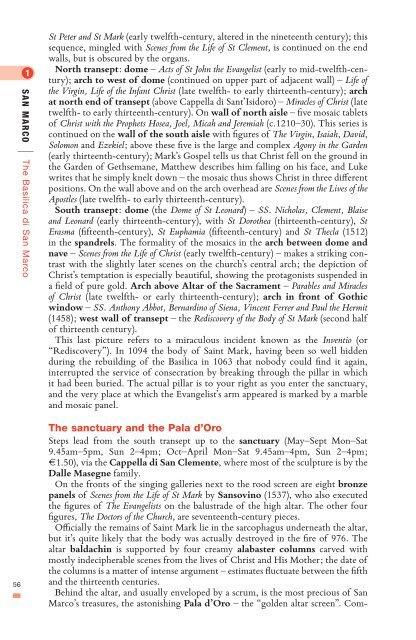Create successful ePaper yourself
Turn your PDF publications into a flip-book with our unique Google optimized e-Paper software.
san marco<br />
|<br />
56<br />
<strong>The</strong> Basilica di San Marco<br />
St Peter <strong>and</strong> St Mark (early twelfth-century, altered in <strong>the</strong> nineteenth century); this<br />
sequence, mingled with Scenes from <strong>the</strong> Life of St Clement, is continued on <strong>the</strong> end<br />
walls, but is obscured by <strong>the</strong> organs.<br />
North transept: dome – Acts of St John <strong>the</strong> Evangelist (early <strong>to</strong> mid-twelfth-century);<br />
arch <strong>to</strong> west of dome (continued on upper part of adjacent wall) – Life of<br />
<strong>the</strong> Virgin, Life of <strong>the</strong> Infant Christ (late twelfth- <strong>to</strong> early thirteenth-century); arch<br />
at north end of transept (above Cappella di Sant’Isidoro) – Miracles of Christ (late<br />
twelfth- <strong>to</strong> early thirteenth-century). On wall of north aisle – five mosaic tablets<br />
of Christ with <strong>the</strong> Prophets Hosea, Joel, Micah <strong>and</strong> Jeremiah (c.1210–30). This series is<br />
continued on <strong>the</strong> wall of <strong>the</strong> south aisle with figures of <strong>The</strong> Virgin, Isaiah, David,<br />
Solomon <strong>and</strong> Ezekiel; above <strong>the</strong>se five is <strong>the</strong> large <strong>and</strong> complex Agony in <strong>the</strong> Garden<br />
(early thirteenth-century); Mark’s Gospel tells us that Christ fell on <strong>the</strong> ground in<br />
<strong>the</strong> Garden of Gethsemane, Mat<strong>the</strong>w describes him falling on his face, <strong>and</strong> Luke<br />
writes that he simply knelt down – <strong>the</strong> mosaic thus shows Christ in three different<br />
positions. On <strong>the</strong> wall above <strong>and</strong> on <strong>the</strong> arch overhead are Scenes from <strong>the</strong> Lives of <strong>the</strong><br />
Apostles (late twelfth- <strong>to</strong> early thirteenth-century).<br />
South transept: dome (<strong>the</strong> Dome of St Leonard) – SS. Nicholas, Clement, Blaise<br />
<strong>and</strong> Leonard (early thirteenth-century), with St Doro<strong>the</strong>a (thirteenth-century), St<br />
Erasma (fifteenth-century), St Euphamia (fifteenth-century) <strong>and</strong> St <strong>The</strong>cla (1512)<br />
in <strong>the</strong> sp<strong>and</strong>rels. <strong>The</strong> formality of <strong>the</strong> mosaics in <strong>the</strong> arch between dome <strong>and</strong><br />
nave – Scenes from <strong>the</strong> Life of Christ (early twelfth-century) – makes a striking contrast<br />
with <strong>the</strong> slightly later scenes on <strong>the</strong> church’s central arch; <strong>the</strong> depiction of<br />
Christ’s temptation is especially beautiful, showing <strong>the</strong> protagonists suspended in<br />
a field of pure gold. Arch above Altar of <strong>the</strong> Sacrament – Parables <strong>and</strong> Miracles<br />
of Christ (late twelfth- or early thirteenth-century); arch in front of Gothic<br />
window – SS. Anthony Abbot, Bernardino of Siena, Vincent Ferrer <strong>and</strong> Paul <strong>the</strong> Hermit<br />
(1458); west wall of transept – <strong>the</strong> Rediscovery of <strong>the</strong> Body of St Mark (second half<br />
of thirteenth century).<br />
This last picture refers <strong>to</strong> a miraculous incident known as <strong>the</strong> Inventio (or<br />
“Rediscovery”). In 1094 <strong>the</strong> body of Saint Mark, having been so well hidden<br />
during <strong>the</strong> rebuilding of <strong>the</strong> Basilica in 1063 that nobody could find it again,<br />
interrupted <strong>the</strong> service of consecration by breaking through <strong>the</strong> pillar in which<br />
it had been buried. <strong>The</strong> actual pillar is <strong>to</strong> your right as you enter <strong>the</strong> sanctuary,<br />
<strong>and</strong> <strong>the</strong> very place at which <strong>the</strong> Evangelist’s arm appeared is marked by a marble<br />
<strong>and</strong> mosaic panel.<br />
<strong>The</strong> sanctuary <strong>and</strong> <strong>the</strong> Pala d’Oro<br />
Steps lead from <strong>the</strong> south transept up <strong>to</strong> <strong>the</strong> sanctuary (May–Sept Mon–Sat<br />
9.45am–5pm, Sun 2–4pm; Oct–April Mon–Sat 9.45am–4pm, Sun 2–4pm;<br />
e1.50), via <strong>the</strong> Cappella di San Clemente, where most of <strong>the</strong> sculpture is by <strong>the</strong><br />
Dalle Masegne family.<br />
On <strong>the</strong> fronts of <strong>the</strong> singing galleries next <strong>to</strong> <strong>the</strong> rood screen are eight bronze<br />
panels of Scenes from <strong>the</strong> Life of St Mark by Sansovino (1537), who also executed<br />
<strong>the</strong> figures of <strong>The</strong> Evangelists on <strong>the</strong> balustrade of <strong>the</strong> high altar. <strong>The</strong> o<strong>the</strong>r four<br />
figures, <strong>The</strong> Doc<strong>to</strong>rs of <strong>the</strong> Church, are seventeenth-century pieces.<br />
Officially <strong>the</strong> remains of Saint Mark lie in <strong>the</strong> sarcophagus underneath <strong>the</strong> altar,<br />
but it’s quite likely that <strong>the</strong> body was actually destroyed in <strong>the</strong> fire of 976. <strong>The</strong><br />
altar baldachin is supported by four creamy alabaster columns carved with<br />
mostly indecipherable scenes from <strong>the</strong> lives of Christ <strong>and</strong> His Mo<strong>the</strong>r; <strong>the</strong> date of<br />
<strong>the</strong> columns is a matter of intense argument – estimates fluctuate between <strong>the</strong> fifth<br />
<strong>and</strong> <strong>the</strong> thirteenth centuries.<br />
Behind <strong>the</strong> altar, <strong>and</strong> usually enveloped by a scrum, is <strong>the</strong> most precious of San<br />
Marco’s treasures, <strong>the</strong> as<strong>to</strong>nishing Pala d’Oro – <strong>the</strong> “golden altar screen”. Com-







